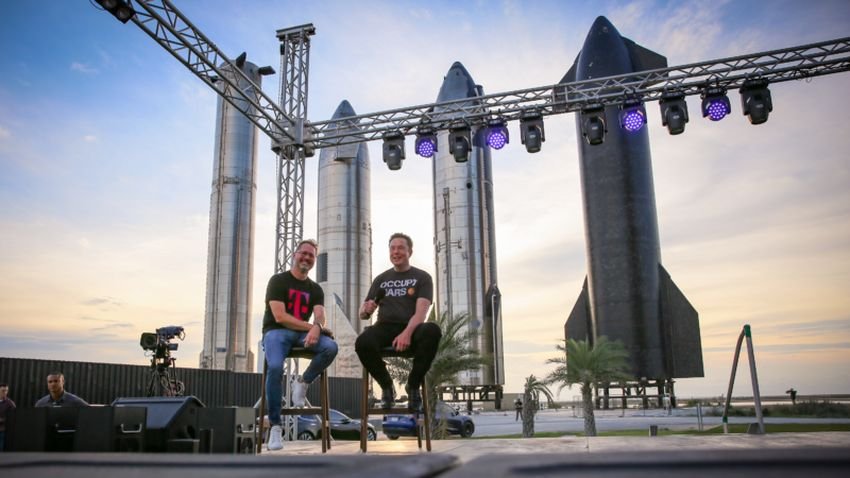SpaceX and T-Mobile announced this week an ambitious plan to provide from space connectivity to anyone with a mobile phone.

Their plan, which will initially begin in America, will combine SpaceX's Starlink satellite technology with the second largest wireless carrier in the United States, T-Mobile US. They will use the mid-band frequency spectrum, mobile network and large customer base.
But all this takes time and big changes. First, bringing internet to mobile phones will require SpaceX to complete development of the second generation of Starlink satellites. These new satellites will be significantly larger than the current ones, which have a mass of about 295 kg. SpaceX founder and chief engineer Elon Musk said the ambitious plan could enter beta service before the end of 2023.
But, let's take the story from the beginning. During one live event last Thursday, at SpaceX's Starbase facility in South Texas, where the company builds and tests its next-generation Starship rocket, Musk appeared alongside T-Mobile US CEO Mike Sievert.
The two companies propose to offer a service that we have dreamed of since the appearance of mobile phones. A mobile phone service without dead zones. As Sievert said: "Our vision is, if you have a clear view of the sky, you're connected."
How would it work?
Επί του παρόντος, ένας χρήστης της υπηρεσίας Starlink του SpaceX πρέπει να έχει μία κεραία σε σχήμα πιάτου για να μπορεί να συνδεθεί στο ευρυζωνικό Internet, με έναν από τους 2.800 δορυφόρους Starlink, που κινούνται σε χαμηλή τροχιά πέριξ της Γης. Οι υπάρχοντες δορυφόροι απλώς δεν είναι αρκετά ισχυροί για να συνδεθούν με πολύ μικρότερα κινητά τηλέφωνα, καθώς το σήμα είναι πολύ αδύναμο.
The solution to this problem is the use of a much more powerful antenna that will be installed on the second version of the Starlink satellites. Musk said that the body of these satellites will be about 7 meters long and the antenna will fold about 5 meters to the side (or about 25 square meters). As the satellite passes overhead, this antenna will send and receive data along a focused beam that passes over the planet's surface.
Initially, at least, the service would not provide broadband internet service. But as a typical cellular cell, it should provide up to 2 to 4 megabits of data, enough for thousands of voice calls ή εκατομμύρια μηνύματα κειμένου. Αυτό θα επέτρεπε τη συνδεσιμότητα σε περιοχές except δικτύου ή κατά τη διάρκεια καταστάσεων έκτακτης need, as when one earthquake or severe weather prevents service in an area.
A user's cell phone would first look for service from a cellular antenna, but when it found none, instead of telling the user "offline," the phone would look to the sky. It would then draw connectivity from the nearest available satellite, and the software on the satellite would communicate with the user's cell phone as if it were a virtual cell tower on the ground.
Sievert said T-Mobile plans to offer this service to its users for free, initially covering the United States, including Alaska and Hawaii, as well as much of the world's oceans. He called on foreign mobile network operators to partner with T-Mobile and SpaceX and offer mutual roaming around the world.
The challenges in their plan
Beyond regulatory issues, SpaceX faces several significant challenges to make this all work. The main challenge is designing and building large satellites capable of talking to mobile phones.
On this Musk said: “We believe these are the most advanced antennas in the world. They must pick up a very quiet signal from your cell phone. Imagine, that signal has to travel 500 miles and then be picked up by a satellite traveling at 17.000 miles per hour. The satellite also has to compensate very quickly for the Doppler effect due to motion."
Satellites will have to go into space. The V2 satellites are too large for the payload capability of the Falcon 9 rocket. So the full-sized Starlink V2 satellites will have to wait for the much larger Starship rocket to come along. SpaceX is working on it at its Starbase facility in South Texas, but operational launches will likely be at least a year away.
To that end, if the Starship deployment doesn't happen as expected, Musk said SpaceX may develop a Starlink "V2 mini" satellite that could fit and be lifted by the Falcon 9 rocket.
In his comments Thursday night, Musk acknowledged that the company still has a lot of technical work to do, but said the people at SpaceX have made great progress.
The competition
SpaceX has already launched satellites for a competitor in this field, Lynk, and is set to launch the “BlueWalker 2022” demonstration satellite for another company, AST Space Mobile, at the end of 3. Both of these companies are trying to offer services directly to the mobile phone.
Lynk says it has already successfully demonstrated the ability to use ordinary, unmodified cell phones to connect to satellite Internet services. The company currently has one operational satellite in space, but plans to launch more to provide a wider coverage area.
Lynk already has 14 commercial agreements with mobile network operators covering 35 US states. The company expects to receive permission from the US Federal Communications Commission before the end of this year to begin selling commercial services in those states.





